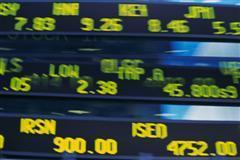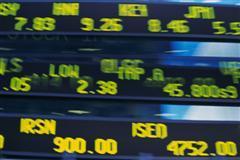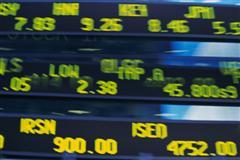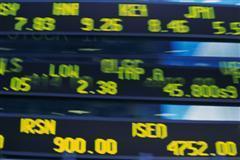| Home | About | Archives | RSS Feed |

@theMarket: A September to Remember
 It was a strong September, the best in 70 years, with the Dow up more than 8 percent for the month while the other averages were not far behind. As the third quarter closes, however, the clear winners were precious metals. But it appears that both commodities and stocks have more to run in the weeks ahead.
It was a strong September, the best in 70 years, with the Dow up more than 8 percent for the month while the other averages were not far behind. As the third quarter closes, however, the clear winners were precious metals. But it appears that both commodities and stocks have more to run in the weeks ahead.
At the close of the week, we had a bit of profit taking in stocks as well as commodities, but that was to be expected. As long as the economic numbers continue to come in better than expected, the data will provide support for further upside in these markets.
This week most of that data surprised analysts. Second-quarter GDP growth rate came in at 1.7 percent versus an expected 1.6 percent and was 3.7 percent in the first quarter. The core PCE price index gained 1 percent versus 1.2 percent expected. Consumer spending gained 2.2 percent versus a prior gain of 1.9 percent. The New York "ISM" Index of business was 58.3% while analysts expected 55.6 percent and the initial jobless claims were down by 16,000 to 453,000, which were also better than expected.
Numbers like these cheer investors and help justify why the stock markets are climbing after four months of range-bound trading. I believe that markets can correct in two ways: a sharp, painful decline or a period of consolidation where stocks trade in a range until all the sellers have sold. Given the historical run-up in stocks from March 2009 through April 2010, I had warned investors that a correction was due and a period of marking time should also occur while the economy played catch-up with the gains in the markets. I believe that is exactly what has happened over the last five months.
The 1,150 level on the S&P 500 Index has proven stubborn resistance this week. Every time the bulls assaulted that line in the sand, the bears fought back, driving stocks lower again, but not by much and that is what gives me confidence that the bulls will break through that level at some point
Over in the commodity corner, gold has powered higher hitting its 11th record high in a month, trading at $1,316 an ounce before falling back to regroup. Silver has had an even more spectacular run and traded above $22 an ounce before also falling back. Clearly investors are "buying the dips" in those markets. I agree with that strategy. Buyers beware, however, because all that "feel good" emotion as precious metals hit new highs can quickly turn to fear and panic when (not if) commodities correct. These puppies have had quite a run, so new buyers would be advised to wait for the inevitable sharp but short pullback before buying.
As for the stock market, if we punch through 1,150, the next resistance area for the S&P 500 is around 1,180. Notice, too, that at that level we will have almost re-traced all the losses incurred since the market's April high.
One final note, I won't be writing a column next week since I'm going to Maine for a week of kayaking and hiking with my wife and our dog Titus. I'll miss you.
| Tags: metals, quarter, growth, correction |
@theMarket: The Line in the Sand
 It would seem that a low-volume battle is being fought over that 1,130-1,150 level on the S&P 500. As I expected, the break above 1,130 occurred this week and now the bulls have to defend it while attempting to push up above 1,150.
It would seem that a low-volume battle is being fought over that 1,130-1,150 level on the S&P 500. As I expected, the break above 1,130 occurred this week and now the bulls have to defend it while attempting to push up above 1,150.
Actually, the S&P reached an intra-day high of 1148 this week. That is the highest level since May 18. Readers may recall that the present correction and subsequent trading range in the markets began with a decline in late April from a high of 1,219. Last week, I wrote that the S&P 500 would break above this trading range.
Also last week I raised my price targets on gold (to $1,350 per ounce) and silver ($36 per ounce) as well as other precious metals. If those metals continue to steamroll higher, I may have to bump up my estimates in the weeks ahead. Both metals continued to make new highs after the Federal Reserve on Tuesday said they were ready to increase their quantitative easing measures a second time if the economy continued to slow. Investors obviously are betting that QE II is in the cards because both commodities took off just minutes after the meeting.
"Explain that to me," asked one client over sushi at Shiro's this week.
Quantitative easing, for those who are unfamiliar with the concept, occurs when the Fed buys securities (in this case, Treasury bonds and mortgage-backed securities) in an effort to inject more money (stimulus) into the economy. Of course, more money in the system can mean higher inflation down the road if that money is used to buy goods and services. So far, that has not been the case.
All that money continues to sit on the sidelines, earning next to nothing because the banks and corporations are afraid to spend it. Since market participants discount today's actions into the future, investors are assuming that QEII will happen and, at some point down the road, that money will be spent. That will almost assuredly trigger a higher Inflation rate, so buy gold and silver now in anticipation. Of course, the best laid plans sometime go awry. Since gold and silver, along with other commodities, are generating big returns, most players are buying first and asking whether it's a good move later.
While commodities take center stage, the bulls and the bears stand toe to toe. Between them, is drawn a line in the sand that could determine whether this market rolls over once again and trades down 10 percent, or continues higher, maybe back to the April highs. I'm betting higher for now. What the bears don't understand is that the game has changed. The Fed has basically given investors a "put" on the market. Either the economy continues to grow or the Fed will come in and backstop the economy with QE II.
| Tags: securities, metals, commodities |
@theMarket: Precious Metals Gain While Stocks Mark Time
 As investors waited for stocks to make up their mind, gold and silver took off this week. Gold made new highs while silver's price level is higher than at any time since 1980. The question is will stocks follow that lead or fall back as they have the last two times the S&P 500 reached this level.
As investors waited for stocks to make up their mind, gold and silver took off this week. Gold made new highs while silver's price level is higher than at any time since 1980. The question is will stocks follow that lead or fall back as they have the last two times the S&P 500 reached this level.
Up until this week, most people (including myself) were betting the market would roll over for a third time and head back to the lows or make new lows. However, thanks to recent economic data that has shed a more positive light on the health of the economy, bullish sentiment among investors has increased to slightly over 50 percent, the highest reading in two years, according to the American Association of Individual Investors. But before you start jumping up and down just three weeks ago those same fickle investors registered the second largest bearish stance in two years. It just indicates how confused we all are about the future direction of the stock market.
In addition, most of us have a trust issue with this market. According to a recent AP-CNBC poll, nearly 90 percent of investors with less than $50,000 and 75 percent of those with $250,000 to invest, believe the stock market is unfair to the little guy. One indication of that sentiment is the continued light volume. Normally after Labor Day volume increases, but the opposite has occurred. That's another sign that market participants are not willing to be burnt a third time. So far this attempt to break out of this four-month trading range has been skittish at best.
All week the market has inched up and down tentatively extending its reach upwards without actually touching the 1,130 level on the S&P. Even if it breaks that level, there is no guarantee that it won't swoon sometime in October. With this much negative sentiment, the contrarian in me is whispering "what if."
What if the markets confound us all and do break out? I must confess that based on the recent economic data and the market's ability to hold the lows over the past few months, I've decided to give stocks the benefit of the doubt here in the short term. However, I am in the "show me" camp. I won't trust this market until I see volume expand and volatility begin to dampen down.
Regardless of what the market does now, I still want to keep some powder dry (cash) at least into October. Further out, I expect a rebound in stock markets which could last for the next two or three quarters.
This is not rocket science. Historically (since 1900) markets do better after mid-term elections, with the uptrend continuing through the first and second quarter of the following year. Couple that history with a growing probability that the GOP will regain sufficient seats in Washington and you have the ingredients for higher markets in the future.
As readers know, I have never believed in a double-dip recession and I have been expecting the economic numbers to improve as more stimulus money is spent and the economy strengthens. That appears to be happening, which will give some fundamental support to my forecast of the market's expected gains.
| Tags: metals, recession, volume |
@theMarket: Is September's Rally Stalling or Pausing?
 After opening the month with a 5 percent market melt-up, investors were expecting a follow-through this week that would take the averages higher. There was even talk of a possible break through the ceiling of this almost six-month trading range. Instead we only managed a couple point gain over last week's close on the S&P 500.
After opening the month with a 5 percent market melt-up, investors were expecting a follow-through this week that would take the averages higher. There was even talk of a possible break through the ceiling of this almost six-month trading range. Instead we only managed a couple point gain over last week's close on the S&P 500.
That was despite some "good" economic news on the unemployment front. Initial unemployment claims were down by 27,000 and continuing claims fell 2,000, the best in two months... The bears argue that not all states submitted employment numbers so optimistic estimates were used instead, in some cases. They also point out that once a person's unemployment runs out they are no longer officially counted as unemployed. The advance guard of this group (those who were left go early in the recession and still have not found a job) exhausted their extended benefits beginning in June. Unfortunately, as time goes bye, more and more unemployed Americans will fall into this category well into the middle of next year.
Over in euro land things were a bit dicier with increased concerns over European debt levels, problems with Anglo Irish Bank and the "news" that Europe's bank stress test understated lender's holdings of risky government debt. Readers may recall that I had grave reservations over this very same issue when the results were first announced weeks ago.
Most of the market's attention has turned to the Obama administration's non-stimulus, stimulus plan. That some Wall Street players got an advanced look at the administration's thinking was, in my opinion, the source of last week's rally. Now that we have the details, the markets seem to be decidedly unimpressed.
As readers recall, I explained that a good portion of the money from the first stimulus plan was deliberately held back until this summer in order to help the incumbent party get re-elected. That may have been a miscalculation on the part of the Democrats, who could have been overly confident of the economic impact of Stimulus One. To date, 77 percent of the $288 billion that was earmarked for tax benefits have been spent, only 53 percent of the $275 billion available for contracts, grants and loans has been distributed and only 64 percent of entitlements, or $144 billion out of $224 billion was doled out to the country. Obviously those levels of spending weren't enough to jump-start the economy or reduce unemployment and people (voters) are angry.
The Obama administration can read the polls as well as you or I. Since offense is always better than defense when running for re-election, the general consensus among Democrats is "we need more spending." The president's new initiatives could cost as much as $250 billion or $300 billion or slightly less than half the first stimulus plan. His agenda includes tax cuts for new business investments and R&D, $50 billion more spending on infrastructure and extending the Bush tax cuts for those Americans who make $200,000 or less ($250,000 if married).
It is not being called another stimulus plan because that might be seen as an admission that the first plan has failed. However on Friday, while addressing the nation on the economy and unemployment, the president did concede that "progress has been painfully slow." Wall Street is already discounting the package as too little, too late and they may be right. They are putting the blame squarely on the president and his party. And this country loves to find a scapegoat.
In the meantime, the markets continue to vacillate on low volume. I'm still expecting stocks to move a bit higher into the 1,130 level on the S&P 500. Only then will there be another opportunity to break out of this trading range decisively and re-take the higher ground. If stocks do succeed in breaking out, I am prepared to change my mind about my 950 S&P target level. But I'm not holding my breath.
| Tags: euro, jobs, stimulus |
@theMarket: Stocks Regain Their Footing and Then Some
 This wasn't supposed to happen. The week before Labor Day is notoriously slow with few, if any gains or losses for the week, but somebody forgot to tell that to the markets. It would appear from the upside action that we are once again going to run the S&P 500 Index back to the top of the range at 1,130. Whether we break that upside resistance remains to be seen.
This wasn't supposed to happen. The week before Labor Day is notoriously slow with few, if any gains or losses for the week, but somebody forgot to tell that to the markets. It would appear from the upside action that we are once again going to run the S&P 500 Index back to the top of the range at 1,130. Whether we break that upside resistance remains to be seen.
I telegraphed readers that we could have a bounce this week but even I was not expecting this much upside.. The rally kicked off on Wednesday, the first day of September, and in just three days the indexes have gained more than 5 percent. Ostensibly, the trigger for this melt-up was some manufacturing data out of China and a positive economic report from Australia that indicated the world's economies were still growing. If you believe that, I have a bridge I want to sell you in Brooklyn.
Although it's tough to prove, I believe the real story behind the market's move is that this week's unemployment numbers were leaked to The Street earlier in the week. This would not be the first time (or the last) that government sources have dropped insider information on their pals within the financial sector. I guess when the government breaks the law its OK.
August's job report indicated that the private sector added more jobs than anyone expected last month, while the Labor Department revised its previously announced data showing even bigger private sector gains in employment were made in both June and July. That's good news for a market that is overly focused on weekly, if not daily, economic and unemployment numbers.
I've recently noticed that everyone has a pet idea on how to reduce the unemployment rate. Everything from tax credits to tightening immigration to make work programs FDR-style have been floated, discussed, critiqued and floated again. So I guess I'll throw in my two cents, given it's the Labor Day weekend. My idea, however, wouldn't cost the taxpayer an extra penny.
Let's say you've been out of work for a year. You are on unemployment but bored to tears, feel like a failure and have just about given up sending out resumes. Why not offer the next prospective employer a deal. You'll work for free over the next six months; that's right, for free, but after six months, if you are doing a good job, the employer pays you for the last three month's work and hires you.
Once agreed, it's all up to you. You've got six months to show your stuff - how hard-working, smart and dedicated you are. The worst that can happen is that you are let go, but in the meantime, you might learn a new skill, tool or trade and possibly unearth other job opportunities.
The employer, meanwhile, receives an added boost to productivity in the form of free labor (minus the start-up costs of training you). That could generate more business for the company in the form of sales and profits, which could help grow the economy. I tried out my idea on several small business owners in the Berkshires.
"I would go for that hands down," said the head of a local engineering company.
"Count me in," agreed the boss of a construction crew, "and if the person showed any sort of initiative, I'd probably pay him for the six months."
Every one of them said it was an idea they would support.
Of course, I recognize the issues involved. On unemployment, you are supposed to be looking for work, not working for free. There would be questions about insurance, possible legal hassles, etc. But possibly the biggest obstacle to overcome is the American attitude that we deserve a job, as opposed to working for one. It is not our God-given right to be employed.
There was a time when I desperately needed a job. Straight out of Vietnam and the Marine Corps, I was paying my way through college in Philadelphia while working on a journalism degree. Borrowing a suit coat and tie, I wrangled an appointment with the editor of the city's largest newspaper.
"If I don't get a front-page story in the next three months, I'll walk," I offered.
The hard-bitten boss of the city desk agreed and subsequently put me in a department that had never published a front-page story in the 100-year history of the paper. Three months later my front-page story sold out the evening edition. I got the job and a journalism award for the best human interest story of the year. It can be done. Try it.
| Tags: jobs |

